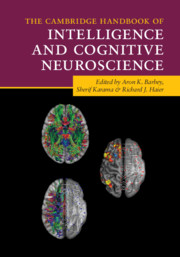Book contents
- The Cambridge Handbook of Intelligence and Cognitive Neuroscience
- Reviews
- The Cambridge Handbook of Intelligence and Cognitive Neuroscience
- Copyright page
- Dedication
- Contents
- Figures
- Tables
- Contributors
- Preface
- Part I Fundamental Issues
- Part II Theories, Models, and Hypotheses
- 5 Evaluating the Weight of the Evidence
- 6 Human Intelligence and Network Neuroscience
- 7 It’s about Time
- 8 A Lifespan Perspective on the Cognitive Neuroscience of Intelligence
- 9 Predictive Intelligence for Learning and Optimization
- Part III Neuroimaging Methods and Findings
- Part IV Predictive Modeling Approaches
- Part V Translating Research on the Neuroscience of Intelligence into Action
- Index
- References
7 - It’s about Time
Towards a Longitudinal Cognitive Neuroscience of Intelligence
from Part II - Theories, Models, and Hypotheses
Published online by Cambridge University Press: 11 June 2021
- The Cambridge Handbook of Intelligence and Cognitive Neuroscience
- Reviews
- The Cambridge Handbook of Intelligence and Cognitive Neuroscience
- Copyright page
- Dedication
- Contents
- Figures
- Tables
- Contributors
- Preface
- Part I Fundamental Issues
- Part II Theories, Models, and Hypotheses
- 5 Evaluating the Weight of the Evidence
- 6 Human Intelligence and Network Neuroscience
- 7 It’s about Time
- 8 A Lifespan Perspective on the Cognitive Neuroscience of Intelligence
- 9 Predictive Intelligence for Learning and Optimization
- Part III Neuroimaging Methods and Findings
- Part IV Predictive Modeling Approaches
- Part V Translating Research on the Neuroscience of Intelligence into Action
- Index
- References
Summary
The search for the biological properties that underlie intelligent behavior has held the scientific imagination at least since the pre-Socratic philosophers. Early hypotheses posited a crucial role for the heart (Aristotle; Gross, 1995), the ventricles (Galen; Rocca, 2009), and the “Heat, Moisture, and Driness” of the brain (Huarte, 1594). The advent of neuroimaging technology such as EEG, MEG, and MRI has provided more suitable tools to scientifically study the relationship between mind and brain. To date, many hundreds of studies have examined the association between brain structure and function on the one hand and individual differences in general cognitive abilities on the other. Both qualitative and quantitative reviews have summarized the cross-sectional associations between intelligence and brain volume (Pietschnig, Penke, Wicherts, Zeiler, & Voracek, 2015), as well as more network- and imaging-specific hypotheses which suggest a key role for the frontoparietal system in supporting individual differences in intelligence (Basten, Hilger, & Fiebach, 2015; Deary, Penke, & Johnson, 2010; Jung & Haier, 2007). These findings are bolstered by converging evidence from lesion studies (Barbey, Colom, Paul, & Grafman, 2014), cognitive abilities in disorders associated with physiological abnormalities (Kail, 1998), and the neural signatures associated with the rapid acquisition of new skills (Bengtsson et al., 2005).
- Type
- Chapter
- Information
- Publisher: Cambridge University PressPrint publication year: 2021



